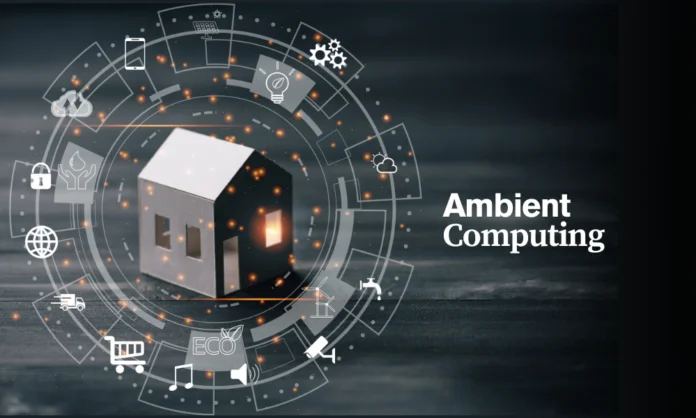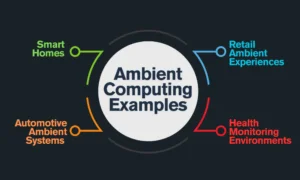Do you recall your first conversation with Alexa or the moment your thermostat decided to warm your house before you arrived home? This is ambient computing in action, a technology that is invisible while not in use yet present when needed. It’s the change from computers as separate entities with which we interact to their computing power.
This isn’t some far-off sci-fi concept. It’s happening right now. By 2032, industry analysts predict that the worldwide ambient intelligence market will have grown to an astounding USD 172.32 billion. The basic principle underlying this enormous expansion is that people should adapt to technology, not the other way around.
What is Ambient Computing?
It represents a paradigm shift from traditional computing interfaces. It doesn’t actively engage with specific devices. Ambient systems blend into our surroundings, creating an ecosystem of interconnected technologies that anticipate needs and respond without explicit commands.
Technology continuously collects contextual information from our surroundings. Your automobile automatically changes the temperature according to your preferences, your lights dim when you start a movie, and your smart fridge detects that you’re running out on milk. No buttons were pressed. No screens were touched.
The underlying architecture successfully makes technology disappear even as it grows more prevalent in our lives by combining edge computing, machine learning, and IoT connectivity to make judgments based on your behaviors and habits.
In What Ways Is It Altering How We Use Technology?
Remember spending hours learning how to use a new device? Ambient computing is completely changing that. It adjusts to our innate habits rather than requiring us to master tech-specific languages and interfaces. Explicit orders are giving way to implicit interactions, in which systems identify human patterns and react appropriately (“Hey Siri, turn on the lights”).
The cognitive load of navigating digital interfaces is vanishing as computing becomes contextually aware and environmentally responsive. We are seeing the emergence of technology that is genuinely frictionless. Rather than technology demanding our attention, it recedes into the background while still delivering value. We are increasingly oblivious to the most profound innovations.
What Are Its Examples?
Smart Homes
Voice commands are no longer enough for smart homes to automatically recognize patterns. When someone enters a room, motion sensors detect it and adjust the illumination based on the activity and time of day. The system learns over time, so when a person is up late working, it maintains brighter light in the office.
Retail Ambient Experiences
Nowadays, some stores integrate ambient intelligence to make shopping seem nearly magical. As customers explore, sensors monitor their movements and preferences to provide tailored suggestions on adjacent panels. In modern tech stores, digital price tags adjust based on loyalty status.
Health Monitoring Environments
There has been significant progress in ambient health monitoring from basic fitness trackers. Unobtrusive sensors are used in senior living facilities to track sleep habits, mobility patterns, and even the frequency of bathroom breaks. Before symptoms become evident, these systems can identify odd nighttime activities that may indicate health problems.
Automotive Ambient Systems
Cars have quietly become showcases of this technology without drivers really noticing. Depending on who is driving, modern cars can change the temperature, audio selection, and seat posture. Cabin monitoring systems use tiny changes in posture and eye movements to identify driver weariness.
What Are Its Downsides?
Despite its ease, this technology presents significant privacy issues that should not be disregarded. These technologies generate previously unheard-of data trails on personal habits and behaviors since they are dependent on continuous environmental monitoring. Every activity, discussion, and exchange turn into a potentially trackable piece of information.
Security vulnerabilities also multiply exponentially as computing dissolves into our surroundings. When a single computer is replaced by dozens of networked devices, the attack surface increases significantly. Strong security procedures are absent from many ambient devices because of financial limitations and the need for downsizing. Securing distributed ambient systems becomes vastly more complex than traditional computing environments.
Wrapping Up!
There is more to ambient computing than just a popular term in technology. It signifies a dramatic shift in how technology permeates daily life. You might expect computing to become less visible and more responsive to human needs as these systems advance.
This technology has both thrilling potential and somber challenges in store for the future. Businesses and cultures that are able to balance demands for security and accessibility, as well as convenience and privacy, will design a future where technology truly serves humanity rather than needing our constant attention.
Visit YourTechDiet to stay updated about the latest trends in technology like Ambient Computing.
Also Read:
Requirement and Purpose of Virtualization in Cloud Computing
Cloud Computing with AWS- An Introduction to Amazon Web Services
Fog Computing vs. Cloud Computing: Difference between the two Explained


